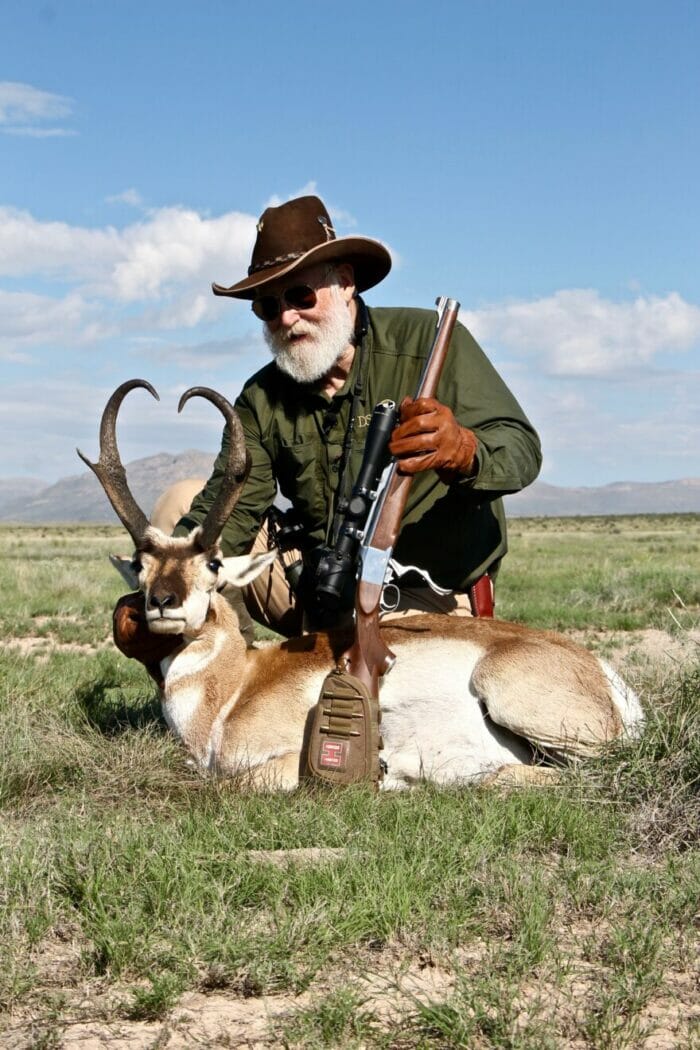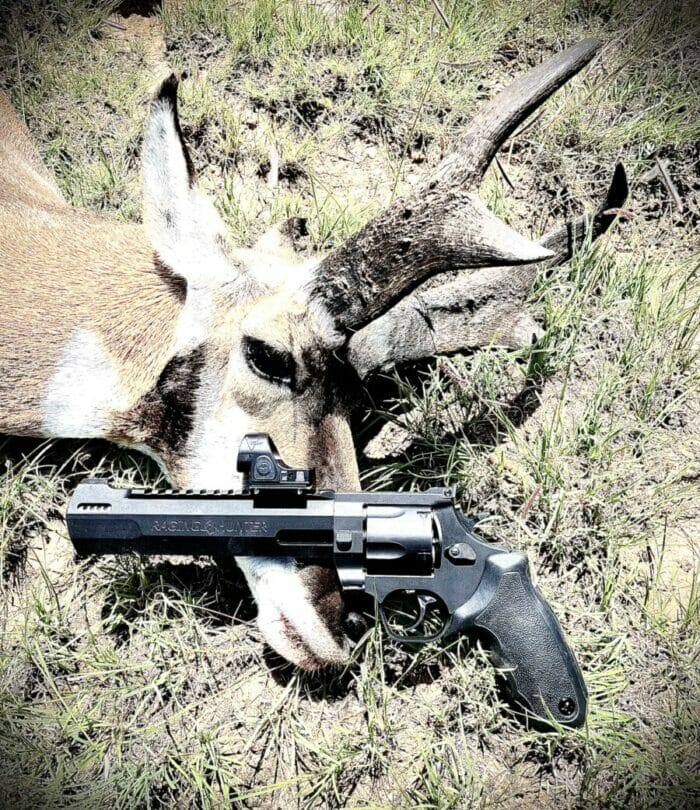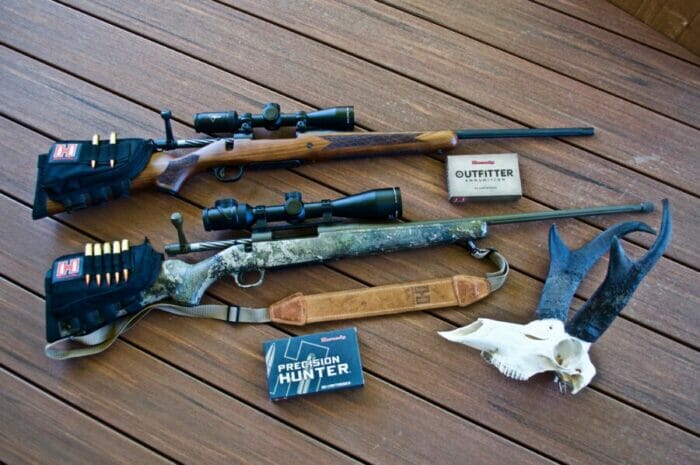Chasing Pronghorns Across the Plains
“He’s just off the property, on State land! Too bad he’s probably fifteen and a half or better, plus he’s got long prongs, better than five inches. Let’s leave and not make him too nervous. Hopefully, he’ll come back this way. He appears to be looking at those five does on the ridge back on our property,” stated my New Mexico pronghorn guide, Keith Stephens, who works with RLE Outfitters.
We eased off the ridge and headed toward our UTV. “We’ll give him a couple of hours. If we don’t find something else we like, we’ll come back and see if that buck is on our side of the fence,” said Keith.
The ranch we hunted was huge, even by New Mexico or Texas standards. It covered a considerable chunk of primarily pronghorn habitat and terrain, but also a few hills which were home to several mule deer and both resident and migratory herds of elk.
Keith said that when he drove into the ranch, he spotted a couple of really good pronghorn bucks on the north side of the property, north of the ranch house between the two taller ridges.
“Chances are they’ll still be in the area,” he said.
Looking for them, we could see some mule deer and elk. The ranch allows very limited elk and mule deer hunting, so bulls and bucks tend to have big antlers. Sounded good to me.
The Quest for a Special Buck
It was the opening morning for my 2022 New Mexico pronghorn season. I had already passed up some really good bucks. I was looking for something special. If I did not find a buck that fit that category, the last afternoon I would try to shoot an over-the-hill buck or go home empty-handed.
Pronghorn hunting is fun and rewarding! Hunting seasons usually occur even before Fall officially arrives. The species, too, is our only remaining true plains big game. Once, bison, as well as elk, roamed the plains and prairies. But those days, for the most part, are gone, even though we again have a considerable number of American bison and elk more than occasionally make their home on the edges of our prairies, often feeding or journeying into the grasslands.
Adaptations and Characteristics of Pronghorns
While pronghorn hear reasonably well, and their sense of smell is pretty good, they live or die based on their visual acuity. Their eyesight is phenomenal! Some have compared it to that of a human aided by an eight-power binocular. Their eyes, too, are situated so they can see nearly 360 degrees of their position. Beyond, they are the fastest land animal in North America.
Pronghorn antelope, beyond being the only true horned animal that annually sheds its horn or outer sheath of horn from a core and grows a new one each year, is also the only true horned animal that develops a prong on each of his horns. Some does also develop horns, albeit considerably shorter than those of the males.
When pronghorn sense or see danger, they run and, as mentioned earlier, they can run fast and often long distances before stopping. The unique species has a special adaptation for being able to “secure” enough oxygen when running. Their trachea is BIG, meaning it is essentially twice, if not more so, than that of a deer of equal size.
Respecting and Conserving Pronghorns
Our North American pronghorn antelope indeed are unique animals. And…they are not a “goat”! I find it demeaning for someone to call a pronghorn a “goat” or “speed goat.” They deserve much greater respect!
Pronghorn antelope are a huge wildlife conservation success story. They once were slaughtered nearly to extinction to provide food for westward expanding human populations as well as satisfying city dwellers “back East.” This was compounded by the building of “sheep-proof” fences throughout their range to keep sheep within the confines of pastures. These mesh-style fences prevented the movement of pronghorn, often to water or where there was better non-competing grazing and browsing. Pronghorn developed on open plains and never had to learn to jump obstacles. Even today, when pressured, the biggest and wisest of bucks and does will try to go under fences rather than through or over them. However, I have seen both bucks and does jump fences better than 3 feet tall. However, this is truly a rarity.
Years ago, hunter/conservationists saw the decline in pronghorn populations and demanded season and bag limits be set on this iconic western species. Then, they helped finance the trapping and translocation of pronghorns back into their historic range. Today, thanks to hunters and wildlife-minded landowners, we have excellent pronghorn herds throughout much of the West.
Over the years, I have eaten pronghorn prepared many ways, from jerky to tacos, burritos and sausages, grilled and fried steaks, and from roasts to soups and stews, and just about any and everything in between. I have had a good-tasting pronghorn and also some that could best be described as “it’s edible….” But as a whole, it’s quite delicious! Care and preparation play a huge role in how pronghorn venison fares on the dinner table.
Pronghorn are judged by their horns, including horn length, length of prong, and four circumferences, utilizing the Boone and Crockett scoring system. Incidentally, normally the blackish horns of mature bucks have almost translucent tips. Horn length is measured from the base to the tip of the horn along the outside edge. Prongs are measured from the middle of the back of the horn to the tip of the prong. Circumferences are measured at the base, and then three additional circumferences per horn, where those measurements are taken, is based to some extent on where the prong starts. For a sample score sheet and an official explanation of where circumferences will be taken, please go to Boone & Crocket. Bucks with horns 13 to 14 inches long are considered good, those 14 to 16 inches long are really good, and those longer than 16 inches great! Over the years, I have taken a fair number of bucks in the 13 to 15-inch length category and a few longer. My longest horn pronghorn is one that is a bit over 17 inches, a buck I shot while hunting in western Texas with Wildlife Systems. It just misses the all-time Boone & Crockett record book, where the minimum net score is 82. However, I think any buck that scores 78 or better on the Boone & Crockett scoring system is a great buck, regardless of how long the horns are.
A quick way to judge a pronghorn’s horns is to look for one where the prong starts above the tip of the ear. Then, too, look for horns that are at least again as long above the prong as below it. I look for one with a lot of mass, one that, from a distance, looks like he has “a whole lot of black” on his head.
Over the past many years, I have taken pronghorn with single-shot and revolver handguns, muzzleloaders, and various single-shot and bolt action rifles, the latter chambered in relatively flat shooting calibers and rounds. Shots at the pronghorn can be long, or at least long, in my estimation. That said, I truly enjoy shooting at long-range steel targets, but when it comes to hunting, I want to stalk as close as possible before pulling the trigger!
Some of my favorite rounds in the past have been.257 Roberts, .270 Win, 7×57, .280 Rem, .308, and .30-06 when it comes to rifles; and .44 Mag and .454 Casull when it comes to revolver rounds. And I have shot pronghorn with other rifle rounds as well. And I have shot several with both .45 and .50 caliber muzzleloaders.
I have two rifles, which I plan to use on future pronghorn hunts. Both are Mossberg Patriots, one a .270 Win and the other a 7mm PRC. Both are topped with Trijicon optics. My .270 wears a Huron a 3-9×40, and the 7mm PRC an AccuPoint 4-16×50. With the.270 I will use Hornady’s Precision Hunter 145-grain ELD-X and the 7mm PRC 175-grain ELD-X. If I find a second pronghorn hunt, I will use my Taurus Raging Hunter .454 Casull, topped with a Trijicon SRO, 2 MOA shooting Hornady’s 240-grain XTP loads. With that latter combination, I would feel comfortable taking a solidly-rested shot out to 200 yards.
It’s time to start booking another pronghorn hunt for next fall!




